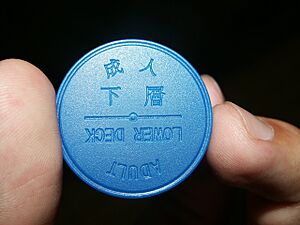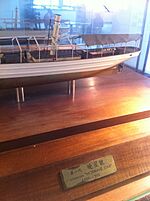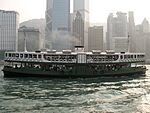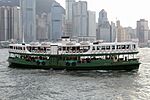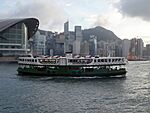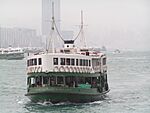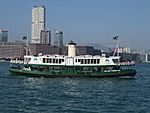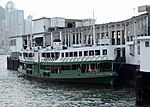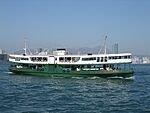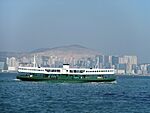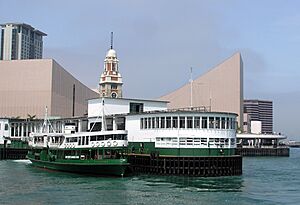Star Ferry facts for kids
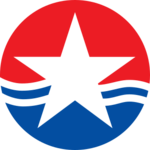 |
|
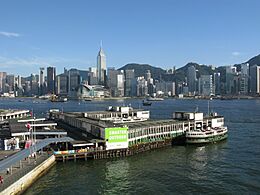
Star Ferry Pier at Tsim Sha Tsui
|
|
| Ferry services across Victoria Harbour | |
| Founded | 1888 |
| Founder | Dorabjee Naorojee Mithaiwala |
| Headquarters | Hong Kong |
| Revenue | HK$72 million (2006) |
| Owner | Wharf REIC (100%) |
| Parent | Wharf REIC |
| Star Ferry | |||||||||||||||||||
|---|---|---|---|---|---|---|---|---|---|---|---|---|---|---|---|---|---|---|---|
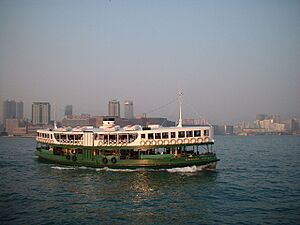
The ferry Meridian Star
|
|||||||||||||||||||
| Traditional Chinese | 天星小輪 | ||||||||||||||||||
|
|||||||||||||||||||
The Star Ferry (Chinese: 天星小輪) is a famous passenger ferry service and a popular tourist spot in Hong Kong. It mainly carries people across Victoria Harbour, connecting Hong Kong Island and Kowloon. The Star Ferry Company runs this service. It started in 1888 as the Kowloon Ferry Company and changed its name to Star Ferry in 1898.
The company has twelve ferries. They carry over 70,000 passengers every day, which is about 26 million people each year! Even though there are railway and road tunnels under the harbour, the Star Ferry is still a beautiful and cheap way to cross. Its main route goes between Central and Tsim Sha Tsui.
The Star Ferry's Journey Through Time
Before steam ferries, people crossed the harbour using flat-bottomed wooden boats called sampans. In 1870, a man named Grant Smith brought a special wooden boat from England. He started offering rides across the harbour, but not on a regular schedule.
In 1873, there was an attempt to start regular steam ferry services. This was stopped for a while. However, a public service likely began in the mid-to-late 1870s. This happened after Kowloon became part of British Hong Kong in 1860.
How the Star Ferry Began
A merchant named Dorabjee Naorojee Mithaiwala started the "Kowloon Ferry Company" in 1888. He bought Smith's boat. Later, he got two more steam vessels from another person, naming them Morning Star and Evening Star.
When the regular ferry service began, sailors on the boats would throw a rope to someone on the pier. That person would catch it with a long pole that had a hook. This old method is still used today!
The ferries became very popular. Within 10 years, Naorojee had four boats: Morning Star, Evening Star, Rising Star, and Guiding Star. Each boat could carry 100 passengers. They made about 147 trips every day. In 1898, he officially named his business the "Star Ferry Co Ltd". The names of the ships and the company were inspired by a poem. It was "Crossing the Bar" by Alfred, Lord Tennyson, which starts with "Sunset and evening star...".
When Naorojee retired in 1898, he sold the company. It was bought by The Hongkong and Kowloon Wharf and Godown Company Limited.
Changes and Challenges Over the Years
A new pier was built in 1906 at Salisbury Road. It was a grand building with separate areas for first and second-class passengers. Sadly, a strong typhoon destroyed it in September 1906.
Around 1912, the Star Ferry caused a stir. It started to only accept Hong Kong currency for payment. Before this, both Hong Kong and Canton (Guangzhou) money were used. This change happened after Canton currency lost some of its value.
In 1924, another company, Yaumati Ferry, also started operating a route to Kowloon. In 1933, the Star Ferry made history. It built the Electric Star, which was the first ferry of its kind to use a diesel-electric engine.
By 1941, the company had six ferries. During the Japanese occupation of Hong Kong, the Japanese took over the Star Ferry for their own use. Two ferries, the Golden Star and the Electric Star, were damaged or sunk during the war. After the war, these ferries were found and put back into service.
In the early 1950s, new ferry terminals were built on both sides of Victoria Harbour. These were designed to handle 55 million passenger trips each year. The new terminals were finished in 1957.
The Star Ferry started operating the Hung Hom route in March 1965. At first, the company was unsure if this route would make money.
Until the Cross-Harbour Tunnel opened in 1972, the Star Ferry was the main way for people to travel between Hong Kong Island and Kowloon.
In February 2009, the Star Ferry was voted first in a poll for the "Top 10 Most Exciting Ferry Rides" by the Society of American Travel Writers.
The Star Ferry operates under a special agreement with the government. This agreement was last renewed in March 2018.
Important Moments and Protests
In 1966, the ferry fare increased by 5 cents. This led to a 27-year-old student going on a hunger strike. His arrest led to protests in Hong Kong.
On November 11, 2006, a significant change happened. The third-generation pier in Central, the Edinburgh Place Ferry Pier, closed down. This pier, with its large clock tower, was removed to make way for new land. Many people protested peacefully against this decision.
Star Ferry Services
The Star Ferry offers several routes across the harbour. Here are the current fares (in HK$) as of February 9, 2021:
Current Routes
- Central to Tsim Sha Tsui:
* Lower deck: HK$4 on weekdays; HK$5.60 on weekends and public holidays. * Upper deck: HK$5 on weekdays; HK$6.50 on weekends and public holidays.
- Wan Chai to Tsim Sha Tsui: HK$5 on weekdays; HK$6.50 on weekends and public holidays.
- Harbour Tour: This is a special tourist cruise. It takes a circular route to all the stops: Tsim Sha Tsui, Central, and Wan Chai.
Passengers can pay for their ride using an Octopus or special tokens (Jeton). You can buy tokens from vending machines at the piers. Direct coin payment at the turnstile is no longer accepted.
The Tsim Sha Tsui – Central route does not allow bicycles. However, the Tsim Sha Tsui – Wan Chai route does allow bicycles for an extra charge of HK$14. This is not allowed during the evening rush hour from Wan Chai to Tsim Sha Tsui.
The Star Ferry also plans to offer a sightseeing service between Tsim Sha Tsui and Hong Kong Disneyland. This route will have two departures. A round trip will cost HK$180. Passengers can enjoy views of the Tsing Ma Bridge during the 45-minute trip on the luxury ferry World Star.
Past Routes
- Central to Hung Hom: This route ended on April 1, 2011.
- Wan Chai to Hung Hom: This route also ended on April 1, 2011.
Renting a Star Ferry
The Star Ferry Golden Star can be rented for private events. It can hold up to 300 people. This ferry has been updated for cruises and parties. It has tables, bigger windows for sightseeing, an air-conditioned area, and a sound system.
Star Ferry Fleet
The Star Ferry currently has 9 diesel-electric ferries and one tugboat.
Here are some of the ferries that have been part of the Star Ferry fleet over the years:
Star Ferry Piers
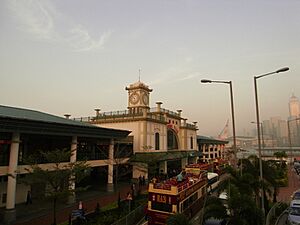
- Star Ferry Pier, Central at Central District:
* The first pier was built in 1890. * The third pier (1957) was near Edinburgh Place. * The fourth pier (2006) is at Man Kwong Street. It has Pier 7 (for Tsim Sha Tsui) and Pier 8 (which became a museum in 2013).
- Star Ferry Pier at Tsim Sha Tsui (1957)
- Wan Chai Pier:
* The second pier (1968) closed in 2014. * The third pier (2014) has been in service since August 30, 2014.
- Hung Hom Ferry Pier: Service ended on April 1, 2011.
Financial Challenges
When the Central Star Ferry Pier moved from its old spot to a new one near the International Finance Centre, fewer people used it. Now, mostly tourists and a small number of daily commuters use the ferry. This has caused the Star Ferry company to lose a lot of money. Because of this, they decided to stop the routes from Hung Hom to Central and Hung Hom to Wan Chai on March 31, 2011.
Star Ferry in Movies
The Star Ferry has appeared in several movies:
- In the 1960 film The World of Suzie Wong, the main character, Robert Lomax, takes the Star Ferry to Hong Kong Island and meets Suzie Wong.
- Brief scenes in the 1988 TV miniseries Noble House are set on the ferry.
- It also appears in the French films Les Anges gardiens (1995) and The Moustache (2005).
Images for kids
See also
- Hong Kong & Kowloon Ferry
- List of places in Hong Kong
- Transport in Hong Kong


